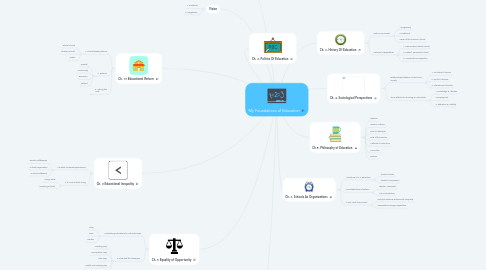
1. Vision
1.1. 1.Traditional
1.2. 2. Progressive
2. Perspective
2.1. 1. Conservative
2.2. 2. Liberal
2.3. 3. Radical
3. Ch. 2- Politics Of Education
4. Ch. 7 Curriculum & Pedagogy
4.1. 1. Historical Curriculum Theory
4.1.1. Social efficiency
4.1.2. Sociology of the Curriculum
4.2. 2. Politics if a National Curriculum
4.2.1. Neoconservatism & Neoliberalism
4.2.2. Curriculum, Testing & Common Culture
5. Ch. 8 Equality of Opportunity
5.1. 1.Calculating Educational & Life Outcomes
5.1.1. Class
5.1.2. Race
5.1.3. Gender
5.2. 2. Class and the Classroom
5.2.1. Reading Gap
5.2.2. Conversation Gap
5.2.3. Role Gap
5.2.4. Health and Housing Gap
5.2.5. Narrowing the Gaps
6. Ch. 9 Educational Inequality
6.1. 1.Student Centered Explanations
6.1.1. Genetic Differences
6.1.2. Cultural Deprivation
6.1.3. Cultural Difference
6.2. 2. It's Not a Black Thing
6.2.1. Acting White
6.2.2. Sampling Schools
7. Ch. 10 Educational Reform
7.1. 1. School-based Reforms
7.1.1. School Choice
7.1.2. Charter Schools
7.1.3. Tuition
7.2. 2. Reforms
7.2.1. Societal
7.2.2. Community
7.2.3. Economic
7.2.4. Political
7.3. 3. Making this Work
7.3.1. Middle Ground
7.3.2. Whole School
8. Ch. 3- History Of Education
8.1. Reform Movement
8.1.1. 1.Progressive
8.1.2. 2.Traditional
8.1.3. 3.Rise of the Common School
8.2. Historical Interpretation
8.2.1. 1. Democratice-Liberal School
8.2.2. 2. Radical- Revisionist School
8.2.3. 3. Conservative Perspective
9. Ch. 4- Sociological Perspectives
9.1. Relationships between School's and Society
9.1.1. 1. Functional Theories
9.1.2. 2. Conflict Theories
9.1.3. 3. Interactional Theories
9.2. Three Effects of Schooling on Individuals
9.2.1. 1.Knowledge & Attiudes
9.2.2. 2.Employment
9.2.3. 3. Education & Mobility
10. Ch.5- Philosophy of Education
10.1. Idealism
10.2. Generic Notions
10.3. Goal Of Edication
10.4. Role of the Teacher
10.5. Methods of Instruction
10.6. Curriculum
10.7. Realism
11. Ch. 6. Schools As Organizations
11.1. 1.Structure of U.S. Education
11.1.1. Private Schools
11.1.2. Student Composition
11.2. 2.Contradictions Of Reform
11.2.1. Teacher Assesment
11.2.2. The Contradiction
11.3. 3. Rich Land Poor School
11.3.1. National Politics & Educational Inequality
11.3.2. Comparative Savage Inequalities

